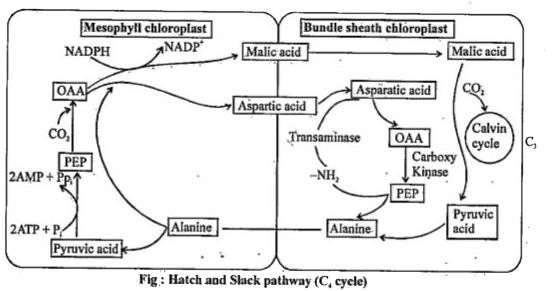Discuss the Dicarboxylic acid pathway of fixation. What is its significance?
Text Solution
Hatch Slack pathway or pathway or dicarboxylic acid cycle: It was discovered by Hatch and Slack in (1965, 1967). It is found in those plants which occur in tropical and subtropical areas.
Examples: maize, sugarcane etc. These plants have another way of fixation in addition to calvin cycle. This is the alternative pathway of fixation. The first stable product is 4-carbon compound, Oxaloacetic acid. Therefore, this pathway is known as cycle. The plants in which cycle operate are called plants. This cycle operates in mesophyll and bundle sheath cells. cycle: This cycle is completed in the following steps:
i) Reaction in chloroplasts of mesophyll cells
a) In cycle, initial fixation of occurs in mesophyll cells. The first acceptor of is phosphoenol pyruvate (PEP). It combines with in the presence of PEP carboxylase to form oxaloacetic acid.
.
b) Oxalo-acetic acid or converted to malic acid or transaminted to aspartic acid. These reactions take place in the presence of enzyme malic dehydrogenase or transminase respectively.
ii) Reactions in chloroplasts of bundle sheath cells :
a) Malic acid or aspartic acid transported to bundle sheath cells through plasmodesmata. Inside bundle sheath cells freed from malic acid and aspartic acid.
.
Aspartic acid + -ketoglutaric acid glutamic acid + oxalo acetic acid.
Oxalo-acetic acid + ATP
b) gas is released in bundle sheath cells. The chloroplast of bundle sheath cells contain enzyme of calvin cycle. So that is fixed to carbohydrates.

c) Above formed pyruvic acid is transported again to mesophyll cells. Here, it is again converted to PEP. The reaction takes place with the help of enzyme and expenditure of energy from ATP.
Significance :
i) plants are better adapted to tropical cIimates.
(ii) plants can absorb even from a much low concentration.
(iii) plants can perform a high rate of photosynthesis even when the stomata are nearly closed.
iv) They maintain the high rate of photosynthesis under drastic conditions.
|
Similar Questions
Why is the C4 pathway called dicarboxylic acid pathway?
View SolutionWhy do C4 plants need to follow an alternative pathway for CO2 fixation.
View SolutionIn C_4 pathway, the first CO_2 fixation occurs in.............. .
View SolutionPGA as the first CO2 fixation product was discovered in cells is an effective transport pathway?
View SolutionDescribe C4 pathway or dicarboxylic acid pathway
View SolutionIn C4 pathway, fixation of metabolic CO2 occurs in which of the following cells?
View SolutionIn sugarcane plant, the dicarboxylic acid pathway was first discovered by:
View Solution
